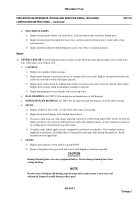TM-9-2350-277-34 - Page 132 of 871
TM 9-2350-277-34
PREVENTIVE MAINTENANCE CHECKS AND SERVICES (PMCS), INCLUDING
LUBRICATION INSTRUCTIONS — Continued
0014 00
3)
Nozzle clearance. Keep nozzle clearance of 1/2 to 5/8 inch (12 to 16 mm) for good gas coverage. Wrong
nozzle clearance will cause the following:
a)
Oxide deposits in the weld bead.
b)
Force gas bubbles into the weld.
c)
Prevent cleaning action on the material in front of the weld pool.
4)
Arc length. You will hear a smooth hissing or buzzing sound when the right arc length is struck.
5)
For further welding instructions, see TC 9-237.
12.
FLUID LEAKS AND CHECKING FOR LEAKS
NOTE
You are allowed to operate equipment with minor leaks (Class I or II). You must consider how
much fluid the item or system being checked or inspected can hold. When in doubt notify your
supervisor. When operating equipment with Class I or II leaks, continue to check fluid levels
as required in your PMCS. Report Class III or fuel leaks to your supervisor, or notify unit
maintenance for corrective action right away.
a.
GENERAL.
Fluid leaks in hoses and fluid lines affect the carrier parts operation.The types and classes of leaks
follow:
1)
CLASS I. Fluid seepage is not great enough to form drops, but is shown by wetness or color changes.
2)
CLASS II. Fluid leakage is great enough to form drops. Drops do not drip from the item being checked or
inspected.
3)
CLASS III. Fluid leakage is great enough to form drops that fall from the item being checked or inspected.
b.
CHECKING FOR LEAKS AFTER A MAINTENANCE TASK.
After doing maintenance on a part which
involves hoses or fluid lines, check for leaks. If leaks occur after you have done a replace or repair task, find the
source of the leak. Correct the problem. Follow these procedures:
1)
Do visual inspections to find the source of the leak.
a)
Check for cracks on housing or cover.
b)
Check that screws and any connections are not loose, or overtight.
0014 00-13
Change 5
Back to Top




















